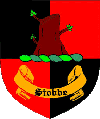Researchers say the surname Stobbe was created in the Low German language area, as the nicknames were added to better distinguish family names during the Middle Ages. They were not arbitrary assigned but often based on specific physical characteristics, family activity, or environmental origin. Thus, to explain the name Stobbe (Variations: Stubbe, Stob, Stobb, Strobe and Stobaeus) often referred Stubben = stump , be it that he ursrünglich as served over or nickname for a short stocky guy, or a name of origin to a landowner was applied, which had Rodeland stumps. In North Frisian dialect of Danish-Holstein space, the word "stobbe" synonymous Erbgrundbesitz (Erbhofstede) be. In the Dutch language Stobbe is the same word as the German high stump. Perhaps erkllärt from the suspected Niederianden in the constitution of the family names.
Applies to the assumption that the origin of the Stobbe family is to look at the geographical area of ?? today Niderlande, would have to be demonstrated before the 14th century, the name there. For 1377 because it is already occupied in Gdansk, where a Matis Stobbe at the "Green Gate" and a Henry Stobbe live in the bread benches alley. From tax records show that in 1401 an Arnold Stobbe and 1403 Tyle Stobbe in Gdansk were taxable.
According to the pre-Reformation period, they will have been citizens of the Roman Catholic faith. For the 16th Century demonstrably based in Browns Mountain Soldau, Graudenz and Konigsberg Stobbes needs that no longer apply.
In the 17th century the name Stobbe between Danzig and Memel is widespread and in all social classes. Here can be by faith separate family groups clearly. Geographically Catholic Stobbes mainly in Warmia find while Mennonite Brethren Stobbes initially appear in the Vistula River area, especially in the Molotschna-Chortiza Mennonite colony settlement east of Danzig, Ukraine in 1788. Protestant or Reformed families are detectable in many places West and East Prussia.
At least with the Mennonites are not descendants Stobbes circulation of products already in the country, but a new influx of people from the Netherlands. There, the Catholic priest Menno Simons had (1496-1561) founded a religious community, which was later named after his Vornamem. They form apostolic wrote communities with strict discipline and adult baptism. 1550 registered volatile Mennonites from Holland in Danziger Werder. About 1562, when the "Doopgesinnten" are increasingly harassed in the Spanish Netherlands, is another influx in Gdansk werder. Mennonites may only lease the land to the next, such as the Good Tiegenhof. Later they will leaseholder and owner.
Whether the ancestors of the extended family Stobbe - Tiegenhof already belonged to this group, or are tightened until later, is not known because a family history of important links are missing.
The first Mennonite Stobbe with the rare name Ertmann is a signatory of the contract spurred on by the Council of Culm (120 km south of Danzig) called for 1597 to 1627. Without further a Erdtmann Location The turn and a Martin Stobbe be on 4 8 1692 mentioned at the conclusion of a lease contract. His son is Ertmann 1704 - menonitisch baptized in the church Montau (60 km south of Danzig) - age in youth.
In the same area and the same period the oldest known ancestor of the extended family lives Stobbe - Tiegenhof, the Hakenbüder (Dealer) Peter Stobbe. We know that he was born before 1690, was a Mennonite, at least temporarily in Neumünster Mountain (30 km südostwärst Danzig) has lived and died in 1736 in the nearby Parco place Schonsee. He had at least seven children, of whom the second son received the name Erdmann - the firstborn was called Peter as the father.
 Return
Return